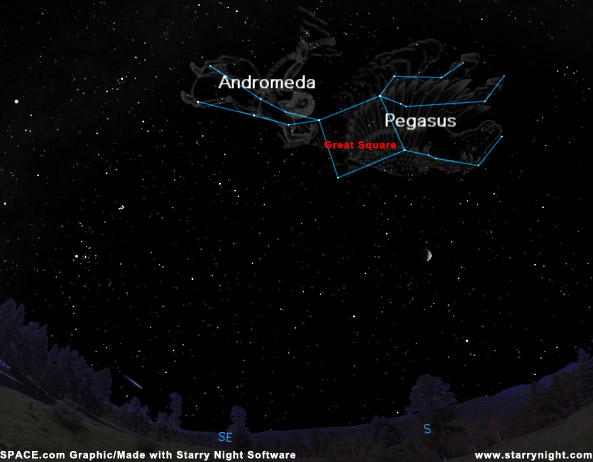
Although winter officially begins on Dec. 21 at 7:40 a.m. EST, one of the landmarks of the autumn sky is still readily visible, high toward the south around 7 p.m. local time.
It's the Great Square of Pegasus, the Winged Horse, an unmistakable star pattern, even though it is slightly battered out of true square shape. Nonetheless, it's a striking figure and once you know it you won't forget it.
Interestingly, one of the stars in the Square - Alpheratz - actually belongs officially to the princess Andromeda. Andromeda according to legend, should be chained to a rock. Instead she seems to have become chained to the horse: a double strand of stars -- one strand bright, the other dim -- connected to the upper left corner of the square.
About midway and above these star strands is the Andromeda Galaxy, lies one of the most amazing and fascinating of sky objects. In the year 905 A.D., the Persian astronomer Al Sufi drew attention amidst the stars of Andromeda to a "Little Cloud" and it appeared on star charts long before the telescope was invented in 1609. If the sky is clear and moonless you can indeed see an elongated hazy patch with your unaided eye about as long as the width of the full Moon and half as wide.
Through binoculars and telescopes it remains an elongated patch which gradually brightens in the center to a star-like nucleus. It was listed as object number 31 in Charles Messier's eighteenth-century catalogue of nebulae, which is why it is known as Messier 31 or M31.
The best way to positively identify the Andromeda Galaxy is to focus your eyes or binoculars on Alpheratz. Run straight across to the left and get the star Mirach in your field of view.
Then run slowly upwards to a fairly bright star above Mirach and continue to run up in roughly the same direction and same distance. You'll immediately take note of a little patch of faint light.
Get the Space.com Newsletter
Breaking space news, the latest updates on rocket launches, skywatching events and more!
Congratulations! You've found Messier 31.
Please forgive this patch of light for being so faint and tired looking. You will when you realize that, as you see it tonight, this light has been traveling some 2,500,000 years to reach you (give or take a few hundred thousand years), traveling all that time at the tremendous velocity of 671 million mph.
The light you are seeing is around 25,000 centuries old and began its journey around the time of the dawn of human consciousness. When it began its nearly 15-quintillion-mile journey earthward, mastodons and saber-toothed tigers roamed over much of pre-ice-age North America and prehistoric man struggled for existence in what is now the Olduvai Gorge of East Africa.
In 1924, Edwin Hubble (1889-1953) and Milton Humason, using the 100-inch reflecting Telescope at Mount Wilson Observatory became the first persons to resolve M31 into individual stars.
We know today, that this "little cloud" is actually a spiral shaped aggregation of over 300 billion stars like our own Milky Way galaxy. This great island universe is the nearest of all the spiral galaxies and one of the largest known.
Basic Sky Guides
- Full Moon Fever
- Astrophotography 101
- Sky Calendar & Moon Phases
- 10 Steps to Rewarding Stargazing
- Understanding the Ecliptic and the Zodiac
- False Dawn: All about the Zodiacal Light
- Reading Weather in the Sun, Moon and Stars
- How and Why the Night Sky Changes with the Seasons
- Night Sky Main Page: More Skywatching News & Features

Starry Night software brings the universe to your desktop. Map the sky from your location, or just sit back and let the cosmos come to you.

Joe Rao serves as an instructor and guest lecturer at New York's Hayden Planetarium. He writes about astronomy for The New York Times and other publications, and he is also an on-camera meteorologist for News 12 Westchester, New York.
Join our Space Forums to keep talking space on the latest missions, night sky and more! And if you have a news tip, correction or comment, let us know at: community@space.com.

Joe Rao is Space.com's skywatching columnist, as well as a veteran meteorologist and eclipse chaser who also serves as an instructor and guest lecturer at New York's Hayden Planetarium. He writes about astronomy for Natural History magazine, Sky & Telescope and other publications. Joe is an 8-time Emmy-nominated meteorologist who served the Putnam Valley region of New York for over 21 years. You can find him on Twitter and YouTube tracking lunar and solar eclipses, meteor showers and more. To find out Joe's latest project, visit him on Twitter.











